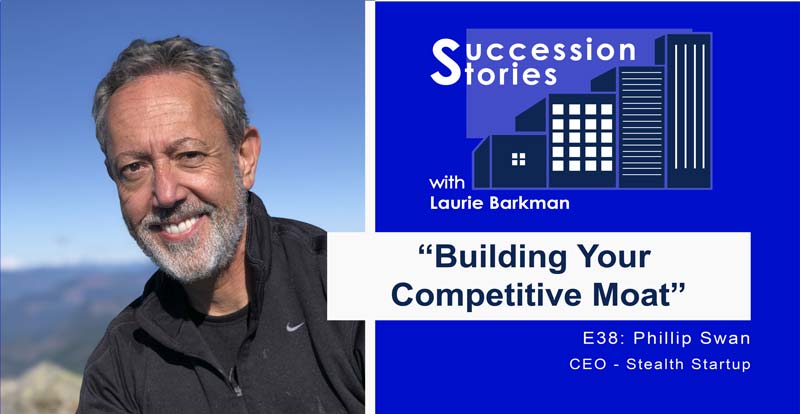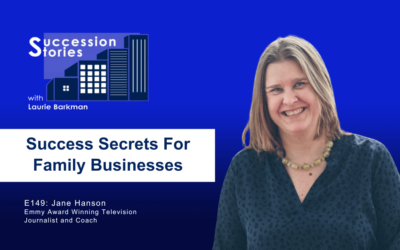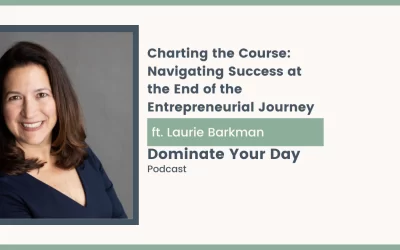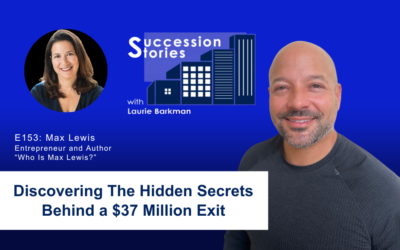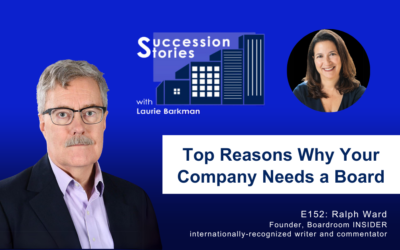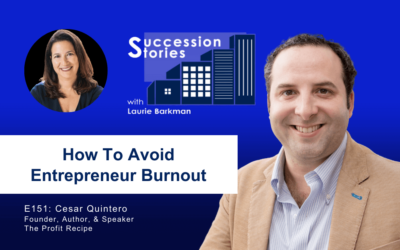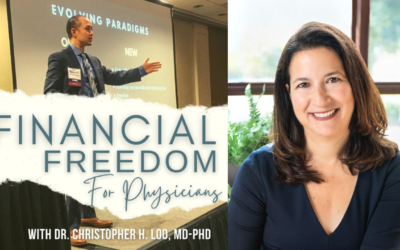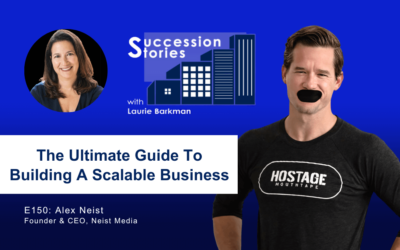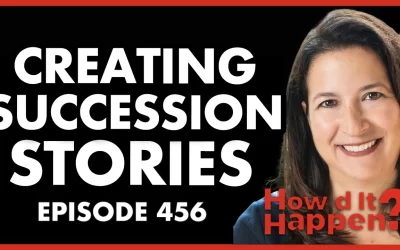Listen to Succession Stories E38:
Want to differentiate your business? Build a competitive moat by mapping out your customers’ journey to discover what matters most to them.
Laurie Barkman, host of Succession Stories, talks with Phillip Swan about creating competitive differentiation through deep customer understanding. From his experience with global companies and high growth startups, Phillip shares insights on how customer experience can create value in your company.
Listen in to learn more about:
- How to understand the customer journey and pain points
- What is customer permission and why it matters
- Customer discovery process
- Creating a strong go-to-market strategy
- Driving value by tapping into what makes your business unique
Show Links
Phillip’s LinkedIn:
https://www.linkedin.com/in/phillip-swan
Connect with the host, Laurie Barkman on SmallDotBig.com and sign-up for an insights newsletter to build value in your company.
Subscribe to the podcast
Subscribe wherever you listen, Apple Podcasts, Google Podcasts, Spotify, Stitcher, and more.
If you enjoy the episode, please give a 5-star rating and review to help others find the content. Here’s a quick how-to guide for Apple Podcasts/iTunes online.
Episode Transcript
Laurie Barkman:
Welcome to Succession Stories, insights for next-generation entrepreneurs. I’m Laurie Barkman. I’ve spent my career bringing an entrepreneurial approach to mature companies struggling with change. As an outside executive of a third-generation 120-year-old company, I was part of a long-term succession plan. Now I work with entrepreneurs privately held companies and family businesses to develop innovations that create enterprise value in transition plans to achieve their long-term goals. On this podcast, listen and while I talk with entrepreneurs who are driving innovation and culture change, I speak with owners who successfully transition their company and others who experienced disappointment along the way. Guests also include experts in multi-generational businesses and entrepreneurship.
If you are a next-generation entrepreneur, looking for inspiration to grow and thrive, or an owner who can’t figure out the best way to transition their closely held company, this podcast is for you.
Subscribe to our newsletter for more resources to build value in your business, visit small.big.com and sign up today.
Originally from Scotland, Phillip Swan is a serial entrepreneur and business builder. He sold his first business at the age of ten, and his second funded his college education. Phillip’s fascination with complex problem solving led him to become a cryptography expert. Scotland is world-famous for its castles. So it’s fitting that we talked about moats, business moats to be more specific. Phillip is an expert at go-to-market and developing deep customer understanding at global companies like Microsoft and T-Mobile. And he’s worked at high-tech growth startups. Listen in for insights on how customer experience can be a moat, a differentiator, and create value in your company.
Laurie Barkman:
Phillip, welcome to Succession Stories. It is awesome to speak with you today. As the audience will soon hear, you have a global background and you’re not from the United States but you live in Washington State. It’s exciting to talk to you about how you’ve become a global business builder. So, welcome to Succession Stories, I’m really glad to speak with you today.
Phillip Swan:
Well, thank you very much. I’m really excited to be here, appreciate the invitation. And yes, I live in beautiful Washington State. People from foreign countries here — I’m from Washington — we think immediately of Washington, DC as opposed to the state. So that’s always a fun education in the geography of the United States to do for people.
Laurie Barkman:
That’s right. You are originally from where? Tell us about your background. Where did you grow up?
Phillip Swan:
Sure. I grew up in Scotland and it’s like New York – it’s a beautiful place to be from. I’m a proud Scotsperson, and I’ve got so much gratitude for the education I received in Scotland. At the time when I grew up, we were blessed with having the number two education system in the entire planet, so I have been blessed with my upbringing. That’s allowed me to travel the world and learn new cultures and learn how to be successful in doing business across the globe. And there are very few places that I’ve never been to for business. So I’m excited to add those to my list at some point in the near future.
Laurie Barkman:
Did you live in other countries?
Phillip Swan:
Yes. So when I graduated, I spent one year working for the British government in the UK and then they transferred me to France for five years and I was working there, and through that work is how I came to the US. I spent five years in Paris so I speak French and it was a very enlightening experience. I’ve always been somebody who is goal driven so at 10 years old, I was traveling with my parents and standing underneath the Eiffel Tower, and I said, “I’m going to live here.” Same thing. My mother’s family was originally from California, and I was able to go to California. When I was 16, I was like, “Well, I’m moving here. This is where I’m ultimately going to live,” and I achieved both of those goals.
Laurie Barkman:
That’s awesome. Walk me through your career. I know you’ve worked with some big name companies like Microsoft and T-Mobile, and you’ve also worked with smaller entrepreneurial companies. So tell me a little bit more about your career and also highlight some of your specialties, if you will.
Phillip Swan:
I’ve always been an entrepreneur. Started off at eight years old, never got a day’s allowance in my life, and my parents always taught me the value of earning your own money and so I started off with a paper at eight years old. I then figured out by nine if I got my friends to help me I could expand my paper route and make more money off of them which I did. And I sold that business to somebody, believe it or not, and I opened up at the age of 14 selling baby clothes at a flea market and paid my way through university. I ended up with 20 stalls in 14 different markets across Scotland.
At 16, I was going to Hong Kong to buy baby clothes, which was really interesting. Being dressed up being this kid and people not taking you seriously turning up with wads of cash saying, “No, I’m buying this,” was a really interesting experience which set me up for what I wanted to do, which was technology. I did have a dream when I was younger, because I come from a medical family, of becoming a doctor. So I don’t live by regrets, but if I do have one regret, it was not becoming a doctor. But at the time, I was convinced not to do it, because it was difficult to be a doctor in a foreign country at that time. So I focused on what I was good at, which was math. And I figured out that computer science would have been a good thing. So I ended up doing math and computer science with a focus on cryptography and parallel computing. I’m a geek at heart and so I worked for 15 years in cryptography.
That got me to travel the world. I went to China for the first time in 1984. I went to Shanghai which at the time had four traffic signals. Pudong, which is its own massive city was a marsh back then. It has been amazing to watch the transformation of China into the global power that it is today and you can talk about the benefits and negatives of that. We won’t get into political discussion on what my thoughts are. But it’s been a really interesting process. I’ve really learned how to do business, not just in China, but in other parts of the world. Because culturally, it is so different, how to adapt and I’m kind of a chameleon, when it comes to that. I can adapt to what people are saying and that’s the key thing that I find successful in my career.
You asked about success, it’s how to transform businesses. When I came out of working for the government, I went to a company called Wind River Systems that we were in the process of taking public. It was completely a military aerospace company, which is interesting, based in Alameda, California, filled in the background with highly progressive people not liking the business we were in. I led the team that drove us into various vertical markets globally, which included automotive and telecom and others. So my big success there was helping to take our company from a $4 stock to $133 in a space of three years and turning a sub $10 million company into greater than $100 million in that timeframe. In today’s day and age, that level of skill happens much faster. But back in the early 90s, that was huge scale back then.
Laurie Barkman:
Yeah, for sure. So you have this knack and specialty in tech. But this turnaround, this, “How do we get from where we are, to where we want to be?” I’ll call it — maybe just starting out within conversation here — sales turnaround, where you’ve come into a company, and really gotten the engine going on revenue generation, how do you do that?
Phillip Swan:
So this is a really interesting question, Laurie, because somebody once asked me what my superpower was, and I’m going “Superpower? I’m not the superhero with a super cape on.” But I really thought about it, and I realized what they were talking about was, what is the one thing I am truly good at? The one thing that I am truly good at is go-to-market and go-to-market isn’t just about selling, it’s about packaging. It’s about identifying channels, it’s about identifying the customer journey, and why people will activate with your products and services.
So I have a pretty compelling capability of being able to zoom out to 30,000 feet and seeing all the paths. Now I’m a big climber. So everything I talk about visually talks about mountains, so I’m able to go and look at the mountain. What’s the mountain peak that we’re trying to get to? What is the mission? And I think in terms of mission– and mission is what is the goal that we’re going after? So what is the peak we’re going after? And the first time you climb that peak, It’s really inefficient. When you think back to when Sir Edmund Hillary climbed Mount Everest with Sherpa Tenzing, it took them three weeks hauling multiple 100 pounds of weight up there. People are doing that in under 10 hours today; that’s the kind of efficiency.
Your initial go-to-market is going to be inefficient because you’ve just got to learn how to climb the mountain. Then you can focus on how to make the rinse and repeat process much more efficient so you can go and scale more mountains that look the same. So my unique ability (fairly unique) is being able to zoom out and seeing all the different paths and all the different routes and then achieving that goal as efficiently as possible. I focus less on efficiency in the beginning then success and proving that success. That is the skill set I bring to every company that I do. Identifying the mountain, the mission, and then the vision about how we’re going to get there.
So the team comes along with it, because 50% of every brand is your organization itself. If your organization isn’t built into the mission, vision, and more importantly, the values, and subsequently the purpose, you have to have a purpose that people can latch onto and hang their hook on. It’s not about following the glorified leader come hell or high water, it’s about “I believe,” and when you truly believe it’s almost cult-like. Startups in many ways are like mini cults, then you believe in what you’re going after. When you have that belief of everybody in the organization, from the lowest level to the highest level in the entire organization working in a transparent way, you have a higher level of success. It doesn’t guarantee success, but you have a much higher level of success.
In the tech world, companies’ failing rates of greater than 80% over five years. Part of the reason is, they don’t understand what the mountain is that you’re climbing and then they run out of cash, because nobody’s there to go and actually welcome you to that mindset. I call that “customer permission,” and it’s getting my permission from the customer to sell you something before you get to any product release; really understanding the customer pain points. Now, I’ve failed more than once and it’s important. Those failures, I’ve learned more from that – and some of them have been blazing failures. When I analyzed, I didn’t truly understand the customer’s pain points and I’ve learned from that. So before I take my time in the go-to-market, and this is the wisdom part of getting older, and taking your time to understand “What pain points does the customer have?” and “Why will she give you permission to sell to her?”
Laurie Barkman:
I think that’s super important, Phillip, and I want to pause on that for a minute in case people are processing, “What does a customer journey mean?” It’s something in the class I teach at Carnegie Mellon. We work with master’s students on a project idea, and they can go deep on tech. But what they really have to start with, and where they start focusing, is on customer discovery, and understanding what is the market opportunity, what problem is to be solved, and then have the tech fit that need. I think a lot of times, and maybe this is what you’ve seen in your experience, there’s great tech out there, and then they go try to find the fit with the customer and so it’s this back and forth. Tell me what you’ve seen with regards to that, and then how that fits in with the customer.
Phillip Swan:
So there’s a great analogy, and it’s a very recent one that I can point to. The best tech doesn’t win, right? It really does not. And part of that is the arrogance by which certain engineering-led organizations live by, “I know better than you, customer. Therefore, I’m going to tell you what to do.” Well, guess what? Customers go, “I’m sorry, but I’m not buying from you. I’m not giving you my hard-earned dollars, because you forced me down a path that’s not natural to me.”
You mentioned the keyword there, Discovery. That’s the area that I spend the most time on with my team; really discovering the customer. In common terms, people talk about that being a persona, and personas are easy to do, because they’re just words. I make them more than just words, I make them the customer comes alive. So when anybody looks at any of my pitch decks these days, they go, “Wow, I understand who this customer is, I can identify with this customer, whether it’s myself, my wife, my brother, my friend, Mike, whomever. This is that person, I see that they will get benefit from this because you understand this customer.”
There’s no shortcut to finding out about that customer. You have to interview and it’s not just about doing three interviews or 10 interviews, you need a minimum of 100 consistent interviews before you can have statistically relevant data. That’s not to say you won’t have a trend before then. But if you’ve got your questions — and this is also a key point to make — questions that are unbiased, you’ll start to see trends after 10 interviews. Then you can start building up more detail and more color around that as you get the number of interviews. And these interviews are not a waste of time, because several of those people will be your initial customers, so you will get them to use the product. And you will get them to give you feedback on the product. And it’s an iterative product process. You spend your time here at the beginning in discovery, you will start the formation with the customer journey.
Customer journeys are data-driven and in the beginning, you don’t have the data so you can only hypothesize about your customer journey. So you start with building the detail into discovery, then you start going into the areas of how you get to the customers’ learning. They actually are engaged about learning, and it’s all about the ‘gives’ and the ‘gets’.
A mistake that many B2B marketers make is when you go to the website — and I’m sure you’ve seen this yourself — it starts asking you for this whole list of questions on, before you can get a white paper, what’s your name? What’s your phone number? What’s your website, what’s your work email? That’s one that ticks me off more than anything. I don’t want your crap coming to my work email. I have an email just specifically for all this other crap, so I won’t give you my work email. You’re creating a barrier to entry and I’m not the only person like that. Remove all barriers to entry to learn about your customer.
If you’re delivering value, you will get more data on the customer. I cannot advise your listeners more. Make it easy for customers to talk to you. Don’t force a phone number if people don’t want to be connected. Get a valid email address. That said, it could be — like me, a specific email address, I’ve got all that junk going to, and not necessarily junk. If it’s interesting, I will subscribe to more and I will give you more information. It’s about drip feeding the gives and the gets.
And I do use the term drip because you can’t force a customer, you will create blocks and barriers to entry if you’re forcing customers down a particular path. People talk about a funnel and I’m changing direction here slightly but very deliberately. People traditionally have thought of this funnel as being this V shaped thing where you have all this stuff coming into the top of the funnel, and how do you drive revenue out of the bottom? Funnels don’t work this way anymore. They’re circular, and at the center of the circle in every company that I do is the customer and I build out from there. How do we nurture that customer? How do we get them to engage with us? How do we get them to acquire? Some people will acquire faster than others. And it’s all about the customer giving you permission, not you forcing on the customer.
When the customer gives you permission, they will buy from you. They will build loyalty into higher customer retention. Because your product is doing what it says it’s going to do for them. Your lifetime value of that customer goes up the more you listen to that customer. You can have more upsell and cross sell opportunities to them. You may not get a flood of numbers of customers, but your value per customer will be much higher, and that’s what investors are looking for.
Laurie Barkman:
That’s a good place to transition because I want to talk about your experience building value and companies for acquisition. I know you’ve acquired some businesses too, and so you’ve been on both sides of the deal in M&A transactions. What are some of the common misconceptions business owners might have about their company when they want to become an acquisition target?
Phillip Swan:
It’s arrogance, quite honestly, it’s the biggest blocker because I have a really nasty expression that I use with a lot of entrepreneurs and I want to be a little bit careful in how I position this so I sound a little hesitant. I’m going to say it, I’m just being a little bit careful. Entrepreneurs can be very full of themselves; “I’ve got the best idea, and you should be buying from me irrespective of that.”
Now the entrepreneurs that are successful, aside from being resilient, are the ones who really understand it comes back to that customer. But again, it’s starting to be realistic about the value of your company and companies are bought, they’re not sold, that’s where you drive value. So when companies are bought, you’ve got to instill fear and greed in the potential acquirer or acquirers. What I mean by that is, value is driven by supply and demand. If you’ve got the best thing with the best customer acquisition, you can show that story. You can drive a much higher multiple of your revenues than you can with somebody who is running out of cash and it’s a fire sale; “I’ve got to sell the company to keep it going.”
When I start a company, I think about legacy. What is the legacy that I want to leave behind? Every company that I have done, and I do mean, every single one from startup still exists in one form or another because I build things to last. When things are built to last acquirers recognize that. That could be on unique technology, that can be in unique value propositions. There are two things; you can either be unique at or best at. Or the cheapest. I never play in the cheapest mode, that’s not my mode.
When you drive value through uniqueness in that nobody else can do it, you’ve built some kind of moat around your business, like in a castle. There are three three kinds of moats that you can build on. One, there’s a cultural moat. Nobody can touch your culture within the company. You are that firestorm.
You’ve seen it in many companies, Shopify is a great example of this and building that culture. But you don’t have to have the best tech. So when you look at Doordash, everybody’s familiar with Doordash, they do not have the best tech. Grubhub had the best tech out there. The difference between Doordash and Uber Eats and all these other delivery services, they have the customer focus. They’ve built a relationship with their users, which has driven their value. They don’t have the best tech out there, but they have the best customer experience and that’s what it comes down to.
If you were to talk to my CTO and the company that we’re starting up right now, and everybody else, my CMO, everybody else that has joined me on this journey that we’re embarking on, the only thing I care about is customer experience. It’s the only thing. When we get customer experience, customers trust you, because they know you’ve got their interests in mind. They know we’re not being arrogant, by trying to push them down a particular path. We’re letting them be in control, and we’re giving them what they need. That’s what Doordash does, and look at the valuation that they got. Airbnb, same thing. Think back to the beginning of COVID; they had to lay off a quarter of their staff. But then it turned out, people could escape cities and spend three months in an Airbnb and their revenues went through the roof. Airbnb is here to stay. Doordash is here to stay. That is legacy. Does that make sense?
Laurie Barkman:
Absolutely. Yeah, it’s a great way to think about it. I think people who are serial entrepreneurs, you use the real description of yourself, as a mountain climber I know you enjoy climbing mountains, and I sometimes call serial entrepreneurs who strive for that climb, “mountain climbers,” too, but it’s more of an analogy. So you absolutely fit. You fit the persona in that sense.
But let’s say for people who are creating, and they are the founder, they are generation one. I’ve talked to some people on this show, who are generation three, four – I have talked to generation 10 – and I think even especially talking to generation one, sometimes people call themselves a founder. They think of it that way. But if you do have this sense of value, and you have a sense of legacy and what you’re building, no matter how you transition it, you’re going to transition in one way or another– that’s life. Whether you choose to sell, whether you choose to transition to family or maybe to a management team, there is a transition that’s going to happen. So what are you going to do from now to then to really build value and maximize value?
I love what you’ve been talking about Phillip, because I think the focus on the customer, the customer centric nature of a company, and how you’ve created that as a leader with your culture. I noticed that when I was looking at your background, and when you and I had talked the first time. I think there are leaders out there that do focus on the customer, but they may be leaning in on tech first. That can be a challenge, this moat that you described. I think that’s one of the things perhaps that Warren Buffett looks for; do you have a moat around your business? And what is differentiating your business? What are those things? If it’s a perception or reality doesn’t matter, as you said, when you’re going to be acquired, you’re being bought, not sold. I think that an awesome phrase.
Phillip Swan:
One thing to add to what I was saying, I mentioned the word legacy before, the only way that I can build a lavish legacy behind me is by having succession planning. I am not indispensable. The thing that many entrepreneurs mistake is that, “Well, I’m indispensable, this is my idea and I know best.” That’s the point where you need to do my favorite term which is remove the founder from the picture because then companies will grow up.
I’m a huge believer that anybody on my executive team could do my job and when I look at my job as CEO, a very simple way that I look at it is that I’m a marshaller of clarity between the customer and my team. People call it the five whys. I am the pain in the neck to everybody because I keep going until we get to that clarity, we’re not doing a darn thing. If I don’t have that clarity myself, then nobody has clarity, right?
So we’re continually driving my clarity. We’re six months into this startup right now and it took us a solid five months to get to that clarity as to what we are doing. And we are going to go and do it. It takes time. Do not rush this process, and always have a backup. You don’t know when you’re going to get sick. You don’t know when you have to take that urgent family trip to go and see a loved one. You don’t know any of that. So you need backups. It’s not about you. And when you leave, who’s going to fill that role? Always have a backup plan; plan A, Plan B, Plan C, plan D.
None of those plans will be right, but what they will do, especially if you train against them and you have — back to our military terminology of rally points — What is your rally point? How do you bring everybody back? When you get lost, where do you come back to? Have those. There’s a reason why the military has this term called force multiplication. It’s not the person on the front lines, it’s the entire organization especially logistics, get your food and everything else that you need to survive in the field. It’s the same thing. People hate that military analogy. I’m sorry, but it works. And it’s worked successfully for me my entire career. Everybody understands that we can go off in their own directions and do it. But when the crap hits the fan, as it always does — let’s be realistic startups, you don’t know what you don’t know, what’s your rallying point — you have to come back and then you have to regroup then you can go out again. Test, learn, invest. Test, learn, invest, I cannot stress this enough for people. There’s no magic, huge leap forward. It’s the baby steps forward, and learning from your mistakes.
Laurie Barkman:
I totally agree with that. I’m a big fan of testing, learning and investing and use that throughout my career too. I would also want to add into that, this is not just a methodology for startups. I think startups are more agile, they know what they don’t know and there’s definitely a mode of, “Hey, let’s build this and figure it out.” But I think also for well established companies, especially this year, right, as we head into 2021, there are a lot of companies out there that are rebuilding. They’ve built value, they’ve built their business. But this is a year that’s caused them to rethink a lot of things.
There are companies out there listening, thinking about what are they going to do differently? Or what are they doing differently? And how do they make that stick? So perhaps we can talk about that. That’s in context of if you’re a well established business, and you don’t necessarily have the customer discovery process. I think you did a good job earlier of explaining what they might do or what they might think about. How can we encourage companies who are experiencing a rebuild moment, what they might do to reinvigorate the customer discovery process given all of the changes in the market?
Phillip Swan:
That’s a really good question. I have lots of friends who are very senior execs at large “Corporate America” and a consistent theme that has come through in talking to all of these people is how they have had to adapt. As an example, I won’t say who she is but she has the title Chief of something at Microsoft, which means she’s extremely senior, I ran into her at the dog park at 4:45 in the afternoon, a couple of weeks ago and I go, “What the heck are you doing here?”
“Well, I don’t have the daily interruptions. Now I’m able to get my job done in a regular way. I just decided at 4:30, I’m done. And I could go out and do that. Whereas normally, I wouldn’t be done till eight, nine o’clock at night, because I’ve got all of these random distractions.” Now, for an introvert, that’s a great place to be because you’re not having to deal with all of the people. So how did the different personality types — when you’re on the different scales or not, where people are highly extroverted — how are you able to know that?
The companies that I’ve seen be really successful at pivoting, and especially the large ones, create a social environment. We’re using the internet as a tool — not tools like Zoom, not tools like Teams, or anything else — but actually working using the internet as a tool itself to start to create those social interactions with people. They’re doing things like virtual wine tastings, where they’ve got a professional wine test, commonly, they send the wine out to homes. So they’re able to figure out ways to actually drive the social interaction with people, creating games, creating more.
My CMO is an example. She’s an advisor to a company out of Canada. They’re doing virtual charades, virtual karaoke and all kinds of things to keep teams together and having a lot of fun doing it. So it’s not impossible to pivot. The smart ones who are pivoting are still creating that cultural mortar, I call it, and building that culture within those companies. The companies that don’t do that are going to be left behind and are going to be stagnant. Still, understanding the customer is important, but you’ve got to pivot to keep your people happy.
If your people are not happy, if you cannot make people happy — everybody is responsible for their own happiness, but I sure as heck can make an environment where they will not gain that happiness — it’s about how do I build an environment? It starts with us leaders, irrespective of whether I’m leading a team of four or a team of 10,000 is creating that environment where they’re happy, they’re comfortable, they feel safe, secure, listened to, and especially as we’re working with Gen Z-ers and millennials, we’re adapting. It’s not other people, because this is the new generation. These are the new generation of business leaders. And if you’re going to build a legacy, you’ve got to make people feel safe, irrespective of gender, irrespective of race, irrespective of belief systems, you just have to be open, and we just have to stop being so full of ourselves. And there’s nobody more self deprecating than myself. I don’t take myself that seriously, and so I’m always poking fun of myself. So anybody who pokes fun at me I’m laughing with. As long as it’s done respectfully, and that’s the key, do everything with respect, everything with openness. People want transparency. And if you’re working in silos today, that’s a hard place to pivot from.
Laurie Barkman:
Yeah, for sure. Sometimes I ask people to send me quotes that they like, and I want to mention one of them, because I think it relates. This is from a friend of mine, her name is Sunny Erdman. And this quote is, “Success is never owned, it’s rented and the rent is due every day.” The original author of that is Rory Vaden. So thanks, Sunny for submitting that. I think it’s a relevant quote that goes along with what you’re saying. You don’t take yourself too seriously. You’re looking to create successes in your team and what you’re doing, and, you’re doing it every day, it’s not something you’re just banking on and a year from now.
Phillip Swan:
One I use that I live by, and I got it from my old days is, “The only easy day was yesterday.”
Every day, I look forward to that challenge of the new day. The thing that I do is eliminating noise so I can focus on what’s important. What’s important for me, what’s important for my family, and what’s important for my friends, and what’s important for my business. I live by four pillars in my life; my friends and family, my hiking, my ability to go out there, and solving complex business problems. Those are the four things that I live by: family, friends, hiking outdoors, which brings me to my passion for dogs and solving complex business problems. My life is in balance when those four things are working. When I don’t have one, my life is not in balance and I recognize that. Being self aware enough, and not arrogant about what’s important to you, because it goes back to your own happiness. Only you are responsible for your happiness, not for your family, not for your spouse, not for your workers. Because when you’re happy, people are comfortable around you. People do sense negativity and don’t want to be around people who are just complaining all the time.
Laurie Barkman:
What’s the saying? “Your vibe attracts your tribe.”
Phillip Swan:
Something like that.
Laurie Barkman:
I believe that for sure. You mentioned what you’re working on now generically, are you able to talk at all about it?
Phillip Swan:
We’re totally in stealth mode right now. It’s an exciting product. We’re already talking to venture capitalists, we will be launching our app in the February timeframe and it is focused on revenue operations. And what revenue operations is, is the amalgamation of sales ops and marketing ops.
The one thing sales people always talk about is, “You’re not giving me enough leads,” or “We’re giving you a whole bunch of leads.” There’s just this constant conflict, and there’s the old expression, “50% of my marketing works. So just switch 50%.” You don’t have that luxury. Now, you actually have to be able to maximize the spend of every single dollar. You have the fiduciary duty of spending that. Now, salespeople don’t give a crap, excuse my French, about what it costs a company to acquire a customer. They only care about one thing: quarter return and my commission check – if they’re a good salesperson. They’re spending so much of their time on administrative tasks, like in CRM and in ERP and dealing with sales ops. That is consuming their days and is actually causing significant issues around job satisfaction. Because I’m not able to do what they’re doing. They’re hustlers. Good salespeople are hustlers. Make no mistake, they’re not process driven. Everybody likes to talk about the sales process and everything else that’s great for business operations, up to the CEO, you want that stuff, you have to have it, and I’m not trying to eliminate that need, because you have to have it. But your good salespeople are the hustlers.
So how do you actually get the information that you want out of the salesperson’s head without them having to give up significant friction to actually give you what you want? Because in CRM today, your data is minimal at best, and dirty at worst, which means you have no clear understanding of the customer and you’ve spent millions on implementing CRM and ERP. Now make it work. So we are working to augment the data on your existing CRM or ERP system, not replace them. Again, you want to start changing habits, you’re in the wrong business. The way to get customer permission is allow them to keep working the way they like to work, but augment what they’re doing and creep your way into their business, into their life by gradually changing habits. They go, “Holy crap! Why wasn’t I using this before?” That’s the way we’re coming at this. We’re coming at it from the outside then from the salesperson into the enterprise.
Laurie Barkman:
That sounds really compelling. And as someone who has worked with salespeople, we used to say that they’re coin operated.
Phillip Swan:
Correct.
Laurie Barkman:
You talked a little bit about your transitions in your career, and I’ve got to ask you, why now? Why do a startup now at this point, when you could just maybe even put your feet up and walk the dog in the park and go hiking?
Phillip Swan:
That’s a really interesting question. So that comes down to my own DNA, and who I am. My oldest brother is in Australia. I come from a family of achievers, which made for an interesting youth, I’ll tell you, when you have a mother saying, “Your brother’s doing this, and why aren’t you doing that?” We don’t need to get into that, but my oldest brother is a very successful physician in Australia. He is the equivalent of Dr. Fauci in Australia, and so I get to hear all the COVID news for whatever it’s worth. We’re both avid hikers so we typically once a year get together and go hiking somewhere in the world. Last year, we were hiking because my nephew, his son, was getting married in DC. We hiked the Appalachian Trail and he’s 10 years older than me, so I can never retire. And it’s not a financial thing, it’s just who we are. If you recall what I was saying about one of my core pillars of solving complex business problems, I can’t get away from that. Now, what that looks like in 10 years for me is probably very different from doing a startup at my age again, but I have the energy to do another startup. And I’m going to keep doing that until I don’t have the energy to do it anymore.
If your soul isn’t in this game, forget it, you shouldn’t do it and I do mean your soul. You want to start up? Your soul has to be in what you’re doing, and I cannot emphasize this enough. If you have a minute of self doubt on that, walk away. Just walk, find something else to do because if you do not truly believe nobody else will. This is one where you can’t fake it until you make it– you truly have to believe. If you do, you will be successful. As I say to every entrepreneur — because like yourself with Carnegie Mellon, I teach entrepreneurialism at various colleges in this area — I keep saying to people, “You’ve got to wake up every morning with the energy. And if you don’t have that energy, nobody else is going to fill it. Just walk away.” And that’s when I have failed. Because I’ve had the pit bull spirit where I’m locked on to the bone and not letting go. There’s a time to say, “You know what? This isn’t working, you need to let go.” Where I have failed is where I haven’t let go and I’ve kept proceeding on a path that even though I’ve believed it just hasn’t worked. There are times where you know what, you’re just wrong and admitting you’re wrong is a hard thing for many people.
Laurie Barkman:
Understood. Well, Phillip, you have an amazing background as a global business builder. Your entrepreneurial journey is certainly not over. You’ve got an amazing path ahead of you. Still a lot of good work to be done, and I really appreciate you being on the show today. If people want to connect with you, what’s the best way to find you online?
Phillip Swan:
My LinkedIn profile is Phillip Swan. You can find me there. Connect with me there and I’m happy to share my personal email. People who want to email me it’s: phillip.swan@gmail.com. So work through my personal email versus my work email would be perfect.
Laurie Barkman:
Thank you for sharing your experience your insights, your time, and thanks for being on Succession Stories today.
Phillip Swan:
Thank you for having me.
Laurie Barkman:
Innovation, transition growth. Easy to say but hard to do.
If you’re an entrepreneur facing these challenges. I get it. I work with businesses from small to big for strategic planning with your team to achieve your vision.
Visit smalldotbig.com to schedule a call with me. I’d love to connect with you. Be sure to catch the next Succession Stories episode with more insights for next generation entrepreneurs.
Subscribe to Succession Stories and if you enjoy the show, please share a rating and review.
Thanks for listening.

